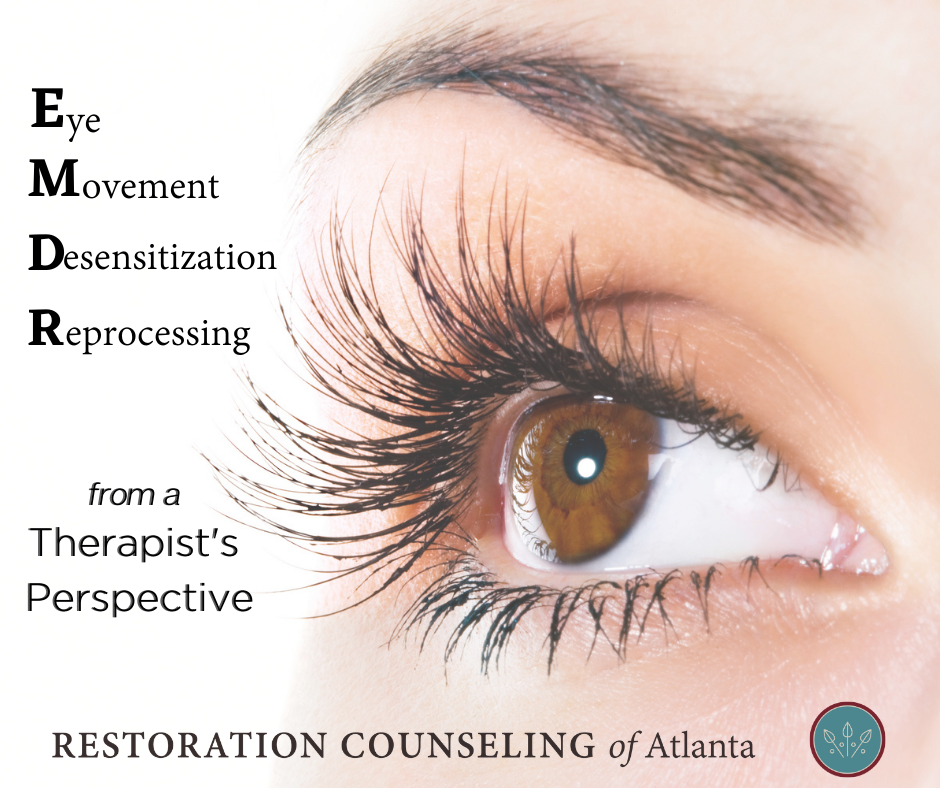What is EMDR?
Eye Movement Desensitization and Reprocessing (EMDR) therapy aids a client in trauma recovery, reducing anxiety, depression, and other symptoms. Francine Shapiro founded the therapy in 1987, and it utilizes bilateral stimulation that helps a client reprocess a specific memory. The treatment changes the way that the client experiences the event so that it no longer triggers them. As a result, they don’t get stuck on that memory.
How does it work?
Eye movement is one method of utilizing bilateral stimulation, but one can also do it by tapping on both sides of the legs. Another technique involves listening to an audio recording with headphones through which sound goes from the left ear to the right. EMDR helps a client reform their experience of a disturbing memory and image. Clients go back to the original memory of what happened to them, so they can reprocess that memory. When this happens, they no longer get stuck, and it no longer provokes anxiety.
What is the benefit of EMDR?
EMDR is a mostly client-centered model where the client has the ability to share little or nothing with the EMDR therapist about what they just processed. In fact, clients will move through things more quickly, with less involvement from the therapist. A major benefit of EMDR therapy is that it allows the client to limit what they want to share with the therapist. Also, it can allow change to happen a lot faster than through regular talk therapy.
What is the therapist’s role?
The first step in EMDR therapy is to do a good history-taking. This helps the therapist learn more about what happened to the client. The history-taking can take a couple of sessions. The EMDR therapist asks the client to state the image that was the most disturbing part of the event.
What is the client’s role?
Next, the therapist leads the client to identify the negative beliefs or shame messages that he has formed about himself based on that memory. Once the client has identified these, the therapist asks them to say what they prefer to believe about themselves. How true do their positive cognitions feel? The client rates the experience on a scale of 0-10, where 10 is the most disturbing experience they can imagine. The goal is to make the experience a 0 or neutral memory.
What does the client actually do?
The EMDR therapist will tell the client to either close their eyes and do tapping or follow their fingers and notice what comes to mind. It is important in EMDR that the client notices only what they are thinking about rather than trying to judge their thoughts. Judging their thoughts can impede the healing process and not allow them to completely open up in their therapy.
There is no wrong way to do EMDR because everyone’s brain will process it differently. I have noticed that the clients who are most concerned about doing it right are the ones who actually have the hardest time with EMDR. It is also hard for clients who have been doing talk therapy to adjust to EMDR. They often prefer to continue to talk instead of processing on their own.
Breaking Old Thought Patterns
Francine Shapiro’s book Eye Movement Desensitization and Reprocessing (EMDR) Therapy describes it this way: “Disturbing events can be stored in the brain in an isolate memory network. This prevents learning from taking place. The old material just keeps getting triggered over and over again. In another part of your brain, in a separate network, is most of the information you need to resolve it. It’s just prevented from linking up to the old stuff. Once we start processing with EMDR, the two can link up. New information can come to mind and resolve the old problems” (Shapiro, 128).
Who is in control?
Another good reminder is that “although unpleasant pictures, sensations, or emotions may come up as we do EMDR, you can stop the process by simply raising your hand. It is best to allow the eye movements to continue as long as possible, but if things feel too rough, you can stop and rest. The idea is that if you want to drive through a dark tunnel quickly, keep your foot on the accelerator so you can go through quickly. Remember that we are only processing old stuff. It may feel real, but it’s just old memories locked in the nervous system. The idea is to let the brain become unlocked, and let the information process through” (Shapiro, 129). The counselor does not ask a lot of questions but directs the client to the new memory they are focusing on.
Why is a therapist needed for EMDR?
A therapist gains knowledge and learns skills for EMDR therapy by going to comprehensive training over two weekends. The therapist learns about EMDR by actually getting to experience it for themselves. A client might be ready for EMDR if they notice that they have plateaued in their growth in talk therapy and are looking for something more and something more in-depth.
Can EMDR be done online?
The client must have a safe place to go once they have tolerated the distress of reliving memories. EMDR therapy is helpful for anxiety, depression, and PTSD. EMDR therapy is just as effective online as it is in person. In fact, I have noticed that some clients actually prefer to do it online rather than in person. Clients can do tapping online, or they can follow a dot across the screen. It is amazing as a therapist to see the client making new connections.
What does the therapist experience?
EMDR is amazing from a therapist’s perspective because I can watch the client form new connections and neuropathways that will last for a lifetime. I recently did EMDR therapy with a client, and between the sets, I asked her what she noticed. She said it was chaotic and she wanted to continue without talking. She automatically went to her safe place when she was finished with the set, and it helped her with the disturbance.
I have been able to see clients have some really powerful mental shifts by using EMDR therapy. I had another client who experienced a lot of abandonment issues growing up. She would get extremely triggered whenever her husband would leave the house while they were arguing. We helped her to reprocess her trauma of being abandoned as a child so that she would allow her husband to have the space that he needed when he was flooded. She realized that they were going to reconnect with one another after they experienced a disconnection. It was amazing to see her experience the healing that she needed.
mead@restorationcounselingatl.com, ext. 115
Roswell and Woodstock Locations
Mead counsels children, adolescents, adults, and families who are struggling with anxiety, depression, communication difficulties, grief, as well as other life issues. She is a certified PREPARE/ENRICH facilitator and also works with premarital couples. Mead’s sincere desire to help her clients experience freedom from fear. She is passionate about helping her clients get out of the rut they have been experiencing and into new, healthy relationship patterns. She will provide a safe environment for healing.


 by
by